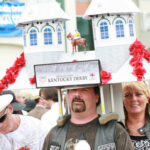Now that the Kentucky Derby is once more on the horizon, it might be well to take a break from handicapping the horses. A look back through the pages of past Derbies yields some surprising details.
How is it that Native Dancer, who won every other race he was in, could lose the 1953 Kentucky Derby? He was far and away the best horse of his year, yet some bad racing luck ruined his otherwise perfect record. At the first turn Native Dancer was bumped hard by a horse named Money Broker, winner of the Florida Derby. Alfred Vanderbilt’s gray champion was knocked off stride. Fortunately, jockey Eric Guerin gathered his horse together and the colt regained his huge rhythmic stride. Native Dancer was third at the top of the stretch, behind only Correspondent and Dark Star. Dark Star had gone to the lead after a quarter mile and never surrendered it. Native Dancer was still gaining but the best he could do was second. Dark Star won at odds of almost 25 to 1. But the spoiler was not Dark Star, it was Money Broker, who finished eighth, and about thirteen lengths behind Dark Star. It is chancy to speculate on why Money Broker swerved so sharply just when Native Dancer was going by him. Was there a fix in the works, or was Broker just a green colt who got nervous in front of the large Derby crowds? Perhaps the answer is in some dark sports archive, waiting for rediscovery. (Bryant, pedigreequery.com, thoroughbredtimes.com)
Has the Kentucky Derby ever been a horse’s first win? Several maiden horses have won the Kentucky Derby. (A maiden is a horse that has never won a race.) Among them is Sir Barton, the first Triple Crown winner in 1919. Another one was Brokers Tip, who won the controversial ‘fighting finish’ in 1933. (thoroughbredtimes.com)
When was the first ‘photo finish’? The first photo finish to determine the winner was used in 1947. The judges needed a photo to decide that Jet Pilot had defeated Phalanx and Faultless at the wire. (Bryant)
Have any father-son duos won the Kentucky Derby? There have been several father-son horses who have won the Kentucky Derby. But there have been two “triples” of another kind, where three successive generations have all captured the roses. The first series involved 1928 Derby winner Reigh Count, who sired 1943 Derby winner (and Triple Crown winner) Count Fleet, who in turn sired 1951 Derby winner Count Turf. The second trio starts with 1944 Derby winner Pensive, who sired 1949 Derby winner Ponder, who sired 1956 Derby winner Needles. (Bryant)
Have any two horses ever run the Kentucky Derby in the exact same time? What was even more incredible about Pensive and Ponder is that father and son ran the distance in the exact same time: two minutes, four and one-fifth seconds. (Bryant)
What horse carried good-luck charms along with his jockey and saddle into the race? In 1963, Chateaugay’s owner attached some chicken wishbones to the saddle of his entry. We can only assume it worked, since Chateaugay was only the third choice of the bettors, behind two undefeated horses. (Bryant)
Who was the first gray horse to win the Kentucky Derby? The first gray horse to win the Run for the Roses was Determine in 1954. He was a very small horse, estimated to weigh only about 870 pounds. Yet he managed to win several prep races in California including the Santa Anita Derby. The following year he was second in the San Juan Capistrano, which is an even longer race of 1 and ¾ mile. The second gray horse to win the Derby was his son Decidedly in 1962, who broke Whirlaway’s record time. (Bryant, pedigreequery.com)
It is a truism that the Kentucky Derby is the first time any of these young horses ever attempt the mile and a quarter distance. Or is it? Few knew that Canonero II had run and won at the Derby distance already, or they might have put their two bucks on him in 1971. What’s more, he ran it on a deep track and at elevation 3,000 feet, in Venezuela where he came from. His South American record was six wins out of ten races (and three thirds) when he arrived to chase the roses. After winning the roses, he annexed the black-eyed susans at the Preakness in Maryland. But when he essayed the mile and a half Belmont, he had a cold and some other ailments; he still managed to hold on to fourth. Canonero II later returned to his native Venezuela, where he died in 1981. (Bryant, pedigreequery.com)
Has any horse won the Kentucky Derby without a prep race? It has also long been a rule of thumb that entrants should have run at least three prep races to get fit enough to run the distance. However, Exterminator won the Kentucky Derby in his first start at age three, in 1918. He had been bought by his new owners just ten days before the race as a workhorse for their star, Sun Briar. When Sun Briar just wasn’t getting sharp enough to run, they decided to enter Exterminator instead. What a surprise when their inexpensive work mate won it all. (Bryant)
Who broke the two-minute mark for the mile and a quarter distance of the Kentucky Derby? Both Secretariat and the second-place horse, Sham, broke the two-minute mark (for the Derby as an event) in 1973. Sham was only a length and a half behind the red champion, and a length is roughly equivalent to a fifth of a second. This was especially remarkable in Sham’s case because he had hit his face against the starting gate, knocking out a tooth. He was said to have bled heavily through the race, yet he was the only horse to offer any challenge to Secretariat in any of the Triple Crown series of races. He would certainly have set a record, and won two legs of the Triple Crown, if not for that one other horse. (Bryant, Jewels)
What do War Emblem and Raven’s Pass have in common? Lord at War was the broodmare sire of both the winner of the 2002 Kentucky Derby (War Emblem) and the 2008 winner of the Breeders’ Cup Classic (Raven’s Pass). He was also broodmare sire to another interesting runner, Pioneerof the Nile, the Bob Baffert trainee who was second in the 2009 Kentucky Derby to Mine that Bird. Lord at War was an Argentine-bred who won the Santa Anita Handicap 25 years ago. Trained by Charlie Whittingham, he beat Gate Dancer, Life’s Magic, and Greinton (GB). He went on to sire 47 stakes winners and total progeny earnings of over $30 million. (This was back when a million was worth something.) (thoroughbredtimes.com)
Who were the oldest jockey and trainer to win the Run for the Roses? My candidate for oldest winning jockey-trainer combination is Bill Shoemaker and Charlie Whittingham. In 1986, they teamed up to get a horse named Ferdinand to the winner’s circle. Whittingham had only had two prior runners in the Derby, neither of whom placed, so he was determined to come back only if he had a viable candidate. He was 73, and his jockey Shoemaker was a mere lad of 54. When the trainer was asked why he had chosen such an old jockey, he replied “Well, he’s not so old. I’m 73!” Bill had piloted three earlier winners in 24 attempts, but it was a long drought of 21 years since his previous trip to the Derby winner’s circle. Ah, life just gets interesting at fifty plus … (Bryant)
SOURCES:
Bryant, Beverley, Portraits of Kentucky Derby Winners, 1995, Health Communications, FL.
Jewels of the Triple Crown (video), CBS/FOX Video Sports, 1989, New York.
Pedigree Query, pedigreequery.com, for lists of stakes performances in addition to family trees, 2010.
Thoroughbred Times, (online archives), Lexington, KY.




